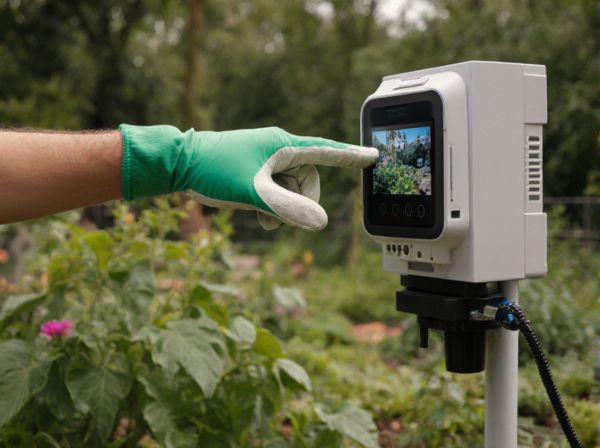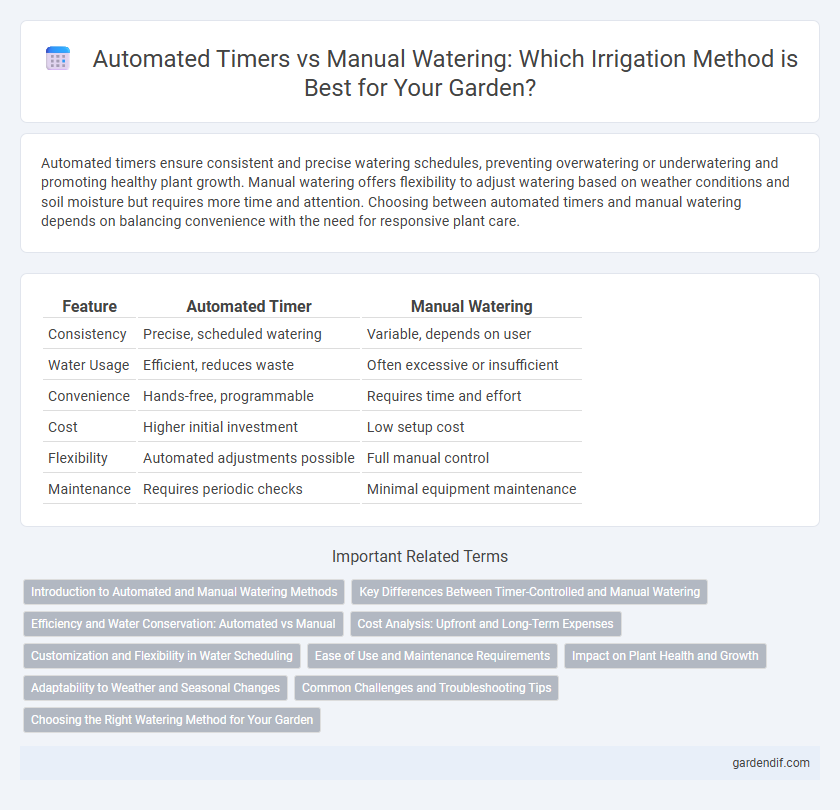
Automated timer vs Manual watering Illustration
Automated timers ensure consistent and precise watering schedules, preventing overwatering or underwatering and promoting healthy plant growth. Manual watering offers flexibility to adjust watering based on weather conditions and soil moisture but requires more time and attention. Choosing between automated timers and manual watering depends on balancing convenience with the need for responsive plant care.
Table of Comparison
| Feature | Automated Timer | Manual Watering |
|---|---|---|
| Consistency | Precise, scheduled watering | Variable, depends on user |
| Water Usage | Efficient, reduces waste | Often excessive or insufficient |
| Convenience | Hands-free, programmable | Requires time and effort |
| Cost | Higher initial investment | Low setup cost |
| Flexibility | Automated adjustments possible | Full manual control |
| Maintenance | Requires periodic checks | Minimal equipment maintenance |
Introduction to Automated and Manual Watering Methods
Automated watering systems use programmable timers to deliver precise amounts of water at scheduled intervals, ensuring consistent irrigation without constant supervision. Manual watering requires hands-on effort, allowing gardeners to adjust watering based on immediate plant needs but often leading to irregular watering patterns. Comparing these methods highlights the efficiency and water conservation benefits of automation against the flexibility and control of manual watering.
Key Differences Between Timer-Controlled and Manual Watering
Timer-controlled watering systems provide precise, consistent irrigation schedules, ensuring optimal water distribution without human intervention, which conserves water and promotes healthier plant growth. Manual watering relies on personal judgment and availability, often leading to irregular watering patterns that can cause overwatering or drought stress. Automated timers eliminate guesswork by delivering water at programmed intervals, enhancing efficiency and reducing labor compared to manual methods.
Efficiency and Water Conservation: Automated vs Manual
Automated timers optimize watering schedules by delivering precise amounts of water at ideal times, significantly reducing water waste compared to manual watering. Manual watering often leads to inconsistent irrigation, increasing the risk of overwatering or underwatering, which diminishes overall water use efficiency. By integrating soil moisture sensors with automated timers, water conservation is maximized through data-driven irrigation management.
Cost Analysis: Upfront and Long-Term Expenses
Automated timers require a higher initial investment for the device and installation but reduce long-term costs by optimizing water usage and minimizing wastage. Manual watering has minimal upfront expenses but often leads to higher water bills and increased labor costs over time due to inconsistent watering patterns. Evaluating long-term water savings and labor efficiency is crucial for a comprehensive cost analysis between automated and manual watering systems.
Customization and Flexibility in Water Scheduling
Automated timers offer precise customization with programmable schedules that adjust watering frequency, duration, and start times to match plant needs and seasonal changes. Manual watering provides flexibility to respond instantly to weather conditions and plant stress but lacks consistency and can lead to over- or under-watering. Combining automated timers with manual adjustments ensures optimal water efficiency and plant health through tailored scheduling and real-time control.
Ease of Use and Maintenance Requirements
Automated timers simplify watering schedules by allowing precise, programmable intervals that reduce user intervention, making them highly convenient for busy gardeners. Manual watering demands consistent attention and physical effort, increasing the chance of missed or overwatering, which can harm plant health. Maintenance for automated timers typically involves periodic battery replacement and system checks, whereas manual watering requires no technical upkeep but greater daily commitment.
Impact on Plant Health and Growth
Automated timers ensure consistent watering schedules that optimize soil moisture levels, promoting healthier root development and balanced nutrient uptake, which directly supports vigorous plant growth. Manual watering often leads to irregular water application, increasing risks of overwatering or drought stress that can stunt growth and make plants more vulnerable to diseases. Precision in irrigation timing and frequency enabled by automated systems significantly enhances plant health by maintaining ideal hydration conditions.
Adaptability to Weather and Seasonal Changes
Automated timers for watering systems adjust schedules based on real-time weather data and seasonal variations, ensuring optimal water usage and preventing overwatering during rainy periods. Manual watering requires constant attention and adjustment from the user to match changing weather conditions, which can lead to inefficiencies or plant stress if neglected. Advanced smart timers integrate moisture sensors and weather forecasts to dynamically adapt watering patterns, promoting sustainable garden management.
Common Challenges and Troubleshooting Tips
Automated timers often face issues like incorrect programming, battery failure, or sensor malfunctions, which can lead to overwatering or underwatering. Manual watering challenges include inconsistent schedules and human error, causing irregular soil moisture levels. Regularly check timer settings, replace batteries, and calibrate sensors while maintaining a consistent manual watering routine to ensure optimal plant hydration.
Choosing the Right Watering Method for Your Garden
Automated timers provide precise control over watering schedules, ensuring consistent moisture levels that promote healthy plant growth and conserve water. Manual watering offers flexibility to adjust to specific plant needs and weather conditions but requires more time and effort. Selecting the right method depends on garden size, plant types, local climate, and your availability to maintain regular watering.
Automated timer vs Manual watering Infographic

 gardendif.com
gardendif.com